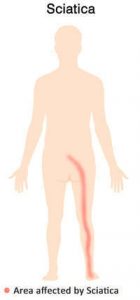SCIATICA
Sciatica simply means problem with the sciatic nerve. Sciatic nerve is the longest nerve in the human body starting from pelvis passing through buttocks, thighs and backside of the leg and ending near the sole of the feet. Typically sciatica affects only one side of the body or only one leg.
Causes of sciatica:
- Compression of the sciatic nerve: When there is bulging (herniation) of disc or extra growth of the bone or bone spur of the vertebra it causes compression of sciatic nerve and this produces symptoms of sciatica.
- Spinal stenosis: The narrowing of spinal canal puts pressure on the sciatic nerve and causes sciatica.
- Trauma: When there is severe trauma to the body resulting in pelvic fracture it causes sciatica.
- In rare circumstances the sciatic nerve can be compressed by a tumor or damaged by disease such as long-term diabetes.
Symptoms Sciatica:
- The peculiarity of sciatica pain is that the pain starts from the lower back to the buttocks and down the legs in one particular line along the nerve pathway.
- Pain could be varying from mild ache to a sharp, electric shock like or burning in nature.
- Constant pain in one leg making it difficult for the patient to sit or stand for a prolonged period of time.
- Feeling of numbness, tingling and weakness of the muscles in the affected leg.
- In severe cases of sciatica patient may experience trouble in controlling the bowels or bladder movement.
Risk factors for Sciatica :
 Prolong standing or sitting: Certain occupations like that of a teacher or bus conductor where there is prolonged standing is required can lead to sciatica in the long run. Same way, some occupations like jewelry making requires prolonged sitting. In long run, this can cause sciatica.
Prolong standing or sitting: Certain occupations like that of a teacher or bus conductor where there is prolonged standing is required can lead to sciatica in the long run. Same way, some occupations like jewelry making requires prolonged sitting. In long run, this can cause sciatica.- Obesity: It is seen that people who are obese are more prone to sciatica. The excess body weight puts extra load on the spine and this may act as a triggering factor for sciatica.
- Age: The age-related changes like herniation of disc or spur on vertebra can cause sciatica in old age.
- Diabetes: Long-term diabetes can damage the sciatic nerve and cause the disease sciatica.
Diagnosis of Sciatica :
- Sciatica can be diagnosed by conducting following tests on the patient.
- X-ray of the spine
- Magnetic Resonance Imaging (MRI): MRI helps in producing detailed images of bone and soft tissues and thus helps in diagnosing the case.
- Computerized tomography scan (CT scan): In this particular test a contrast dye is injected into the spinal canal and X-rays are taken then after.
Treatment for Sciatica :
- a. Physiotherapy: Once the acute pain of sciatica is relieved, the physiotherapist can suggest the patient a few exercises which patient has to do on a day-to-day basis. The physiotherapist may also guide on maintaining the correct posture while sitting or standing. The physiotherapist may also guide on doing some strengthening exercises for the muscles of lower back and stretching exercises for improving the flexibility of the muscles.
b. Conventional treatment: - Medical treatment: This includes prescribing NSAIDS (Non-Steroidal Anti-inflammatory Drugs) and some muscle relaxants for pain relief.
- Steroid injections: In severe cases of sciatica, the doctor may advise the patient to take steroid injections in the area around the involved nerve root. But, the number of steroid shots to be given to the patients is limited because of the serious side effects of the same.
- c. Surgical treatment: In severe cases of sciatica where there is significant damage to the sciatic nerve resulting in bowel and bladder incontinence and in cases where the pain is so severe that it does not come under control with any other therapies, surgeons can perform a surgery on the patient of sciatica.
d. Homeopathic treatment for sciatica: Sciatica is a chronic disease. Homeopathic medicines can play a significant role in relieving sciatica and controlling the disease. Homeopathic medicines given by an experienced doctor along with regular physiotherapy can give a significant relief to the patients suffering from mild to moderate sciatica.
